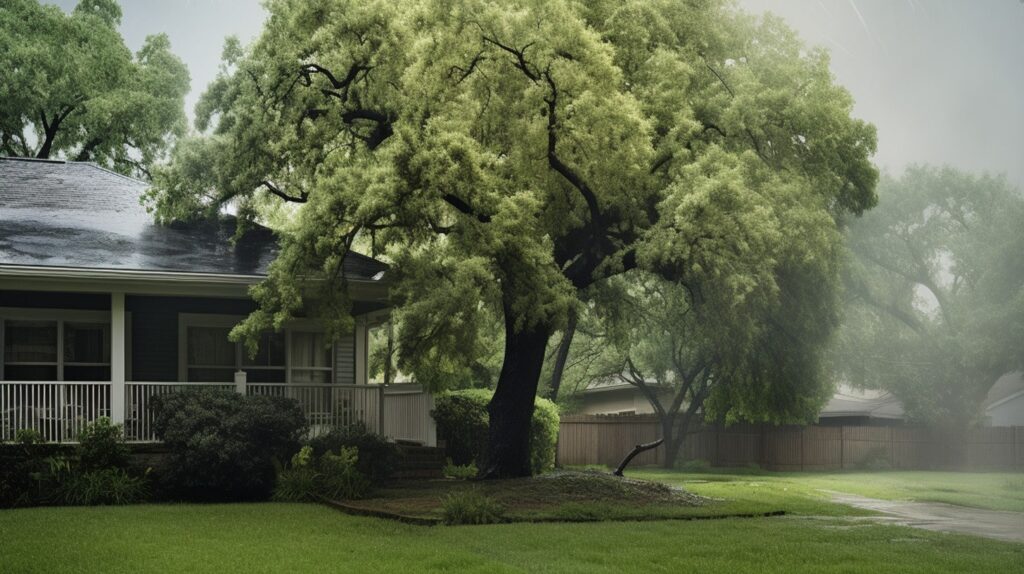Storm Cleanup Guide: Importance of Tarping Your Roof After a Big Storm
Last updated Thursday, August 24th, 2023

Learn How to Safely Tarp Your Roof to Protect Your Home After a Storm
A storm won’t tell you when it’s going to come and go. A bad day could turn into a bad month packed with extreme weather events. Let’s say a storm leaves a hole in your home’s roof during the peak of the monsoon season or winter. You’re still going to deal with weeks of heavy rain or snow ahead.
So if you don’t do anything to cover up your roof, you’re going to face a lot more damage. You’ll have to cough out a fortune fixing both the interior and exterior of your home.
Tarping your roof is the fastest short-term savior for your home. Sure, a giant plastic sheet doesn’t look pretty, but it’s pretty effective at fighting off leaks and holding back light debris. It keeps a roof over your head when you need it the most until you hire a contractor to fix it properly.
In this article, we’ll share six simple steps for tarping your roof safely and how a team of storm damage cleanup professionals can help you achieve this.


When It Comes to Emergencies, Call Your Omaha Storm Damage Cleanup Experts!
Importance of Tarping Your Roof After a Big Storm
Climate disasters caused over $175 billion in property damages in 2022.
Nebraska is prone to all kinds of extreme events. Hailstorms? Check. Heavy rainfall? Plenty of it. Snow storms? Definitely. Tornadoes? It literally sits in the middle of America’s Tornado Alley.
So can you afford to be casual about your damaged roof? Absolutely not!
Any weakness in your roof can give the storm an edge to sneak in through the roof shingles and start ripping it apart. Conducting annual home inspections is probably the best precaution you can take to maintain your roof’s integrity. It’ll allow you to patch up and fix any little issues that could be aggravated by a storm.
But when it’s too late to do that, your next priority should be minimizing your damage and securing your home. Hiring the right contractor and rebuilding your roof can take anywhere between a few days to a few weeks in the middle of storm season.
Ever wonder why you see miles and miles of blue plastic on rooftops of a storm-affected area on the news channel? Those giant plastic sheets are called tarps. And they are the only backup roof people can rely upon to make their homes safe and livable for their families.
They’ll have to replace their home along with their roof if they let the leakages and debris fall in through the damaged roofs.
A waterproof tarp will keep your home nice and dry. It’ll also protect your home from dirt and harsh sun exposure.
How to Tarp A Roof: 6 Simple Steps
- Assess the Roof Damage – You need to evaluate the full impact of the roof damage before you take any action. It’s best to call a professional to safely give you a detailed damage assessment report. Try to identify any signs of damage that could cause any short-term or long-term damage. Make a note of any cracks, dents, missing shingles, debris, or loose nails.
- Check the Weather Forecast – Take refuge someplace safe until you’re sure the weather has stabilized. You don’t want to get caught on your roof in the middle of another storm. Keep an eye on the local weather forecast and wait for a safe period to install the tarp.
- Make Sure the Roof – Your tarp can’t restore your roof’s structural integrity. So trying to install a tarp on a roof that’s on the verge of caving in can endanger your life. In that case, it’s best to let storm damage cleanup experts safely remove the dangerous damaged parts. They’ll use the right equipment to quickly clear this debris and help you figure out how much work your roof will actually need.
- Measure the Surface Area – You need a tarp that can cover the roof hole and extend at least 3 feet beyond it on each side. Use a measuring tape to calculate the exact surface area that will need to be covered. It’s time to head to your local hardware store. You may need to buy thicker or multiple tarps depending on the extent of damage.
- Position Your Tarp and Hold it Down – Installing a tarp on your roof may be too overwhelming to pull off solo. High winds and rain can make it really difficult. Find someone to help you unwrap, position, and hold down the tarp to cover the damaged area. Make sure there’s no debris below the tarp. You can even fold a big tarp if the damaged area is small to enjoy a thicker protection layer. Spread the tarp across your roof, allowing at least 4 feet of tarp to fall on each side of your sloped roof.
- Secure the Tarp in Place – You need a temporary but strong way to hold the tarp in place. It only works as a useful protection if it tightly seals the damaged roof area. You can use a few 2X4 boards to nail the tarp ends into place properly.
Safety Considerations for Roof Tarping

- Wear the proper safety gear for the task. Use goggles, gloves, boots, and protective clothing.
- Avoid installing the tarp if the extreme weather conditions have still not settled down.
- Identify all tripping hazards and imminent threats near your roof like downed power lines or fallen trees. You need to contact emergency storm cleanup professionals to safely clear them before tarping your roof.
- Use a stable ladder that can easily reach the height you need to approach your roof. At least three feet of the ladder should be above the roof’s edge.
- Try to do your repair work without putting your weight on the damaged roof as much as possible.
- Don’t walk on the tarp once you’ve installed it as it’s highly slippery.
Storm Cleanup: Beyond Tarping Your Roof
You can’t do a fair job fixing your roof if you haven’t cleared the damage obstructing repair work.
Tarping your roof is the second step. So what should be your first step? Hiring a trustworthy team of storm damage cleanup professionals who are available 24/7 to help you.
You take this one step and they’ll take care of every other step.
Here’s how they help to secure your home until your contractor fully repairs your roof:
- Assessing the overall storm damage to your property
- Cleaning up debris and fallen branches
- Clearing blocked gutters and downspouts
- Repairing or replacing damaged siding and gutters
- Fixing your roof tarp
Contact Our Team of Storm Damage Professionals
Tree Wise Men’s trusted storm cleanup and repair crew has helped hundreds of homes damaged by storms for over 25 years.
We’re always prepared to handle the unpredictable Midwest weather. Making disaster recovery safer, faster, and cheaper is what we’re known for. And making your home a warm and livable place for your family is what we care about.
Frequently Asked Questions
What should I do if my roof is severely damaged after a storm?
Clear the area under the damaged roof immediately. Move to another location temporarily if you fear there’s a lot of damage and the roof may cave in.
It’s best to contact an emergency storm cleanup and repair service in your local area to take care of this. It’s not worth risking your life trying to inspect or fix a severely damaged roof.
Can I tarp my roof myself, or should I hire a professional?
It depends on the severity of roof damage and your DIY skills. It’s easier to cover up minor damage using some wooden 2X4 boards and nails. But if it feels too challenging, we’ll do it for you after assessing the damage and cleaning up the area.
How long can I leave a tarp on my roof before getting it repaired?
You can keep your roof tarps up for at least 90 days if needed. But tarps are no real roof replacements. it’s best to hire a contractor and get it fixed before another extreme weather event hits your area.
Will insurance cover the cost of tarping and storm damage repairs?
Yes. You can file a claim against your homeowners’ insurance to get compensated for the tarping and storm damage repairs.
Is it safe to tarp a roof during adverse weather conditions?
No. It’s almost impossible to unfold and secure your tarp in extreme weather conditions. You can fall off and injure yourself severely by attempting to do this. Wait till the weather calms down before tarping your roof.
What are the signs that my roof needs immediate tarping after a storm?
Here are a few signs that you need to urgently tarp your roof after a storm:
- Sunlight is scattering through your roof
- There’s water leakage through your ceiling
- Missing shingles and granules
- Wood rot in the area near your roof
- You can see mold develop on the ceiling
- Dents or holes in the roof




